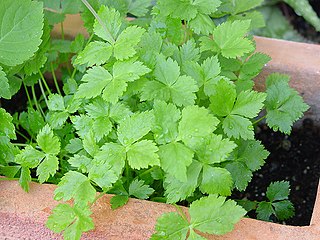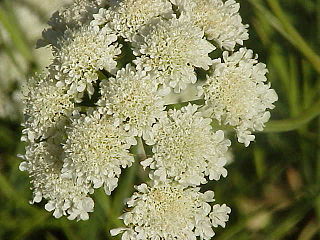
Cryptotaenia, or honewort, is a genus of herbaceous perennial plants, native to North America, Africa, and eastern Asia, growing wild in moist, shady places.

Athamanta is a genus of flowering plant in the family Apiaceae. It is native to southern Europe and northern Africa.

Berula is a cosmopolitan genus of flowering plants in the family Apiaceae, whose species are known as water parsnips, as are some other plants in Apiaceae such as Sium latifolium and Sium suave. It is easily confused with the highly toxic water hemlock.
Neoconopodium is a genus of flowering plant in the family Apiaceae, native to Pakistan and the western Himalayas. It may be subsumed into the genus Kozlovia.

Nirarathamnos asarifolius is a species of flowering plant in the family Apiaceae, and the only species in the genus Nirarathamnos. It is endemic to Yemen. Its natural habitat is rocky areas. It is listed as a vulnerable species on the IUCN Red List.

Todaroa is a monotypic genus of flowering plants belonging to the family Apiaceae. It just contains one known species, Todaroa aurea.

Bolusanthus speciosus is a species of flowering plants in the family Fabaceae. It belongs to the subfamily Faboideae. It is the only member of the genus Bolusanthus.
Ladyginia is a genus of flowering plants belonging to the family Apiaceae.
Turgeniopsis is a monotypic genus of flowering plants belonging to the family Apiaceae. It contains only one known species, Turgeniopsis foeniculacea. The earlier synonym Glochidotheca is also used as the accepted genus name, but Plants of the World Online states that it was not validly published.
Vesper is a genus of flowering plants belonging to the family Apiaceae.
Klotzschia is a genus of flowering plants belonging to the family Apiaceae. It is native to Brazil.
Komaroviopsis is a monotypic genus of flowering plants belonging to the family Apiaceae. It contains only one species, Komaroviopsis anisoptera, native to Uzbekistan in Central Asia.
Korshinskia is a genus of flowering plants belonging to the family Apiaceae. It is also in the Tribe Pleurospermeae.
Lipskya is a monotypic genus of flowering plants belonging to the family Apiaceae. It only contains one known species, Lipskya insignis. It is also in tribe Pyramidoptereae.
Semenovia is a genus of flowering plants belonging to the family Apiaceae. It is in subfamily Apioideae and also tribe Tordylieae subtribe Tordyliinae.
Lalldhwojia is a genus of flowering plants belonging to the family Apiaceae. It is also within the Tribe Tordylieae and subtribe Tordyliinae.
Neonelsonia is a monotypic genus of flowering plants belonging to the family Apiaceae. It just contains one species, Neonelsonia acuminata, native to southern Mexico, Colombia, Costa Rica, Ecuador, Guatemala, Panamá, Peru and Venezuela. It is part of the tribe Selineae.
Krasnovia is a monotypic genus of flowering plant in the family Apiaceae. Its only described species is Krasnovia longiloba, native to Kazakhstan, Kyrgyzstan and Xinjiang. The genus was first described in 1950, and was named after Andrei Krasnov by M.G. Popov. The species was first described in 1842 as Sphallerocarpus longilobus.





